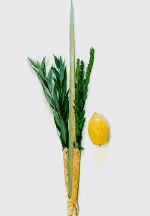The Four Species
And you shall take
for yourselves on the first day
the fruit of beautiful trees, branches of palm trees,
the boughs of leafy trees, and willows of the brook;
and you shall rejoice before the LORD your God for seven days.
Leviticus 23:40
The Four Species
required in the celebration of Sukkot are:
- the fruit
of a beautiful tree (Etrog)
- the
branches of date palms (Lulav)
- the
branches of the myrtle tree (Hadasim)
- the
branches of the willow tree (Aravot)
The
Four
Species
are plainly called Lulav and Etrog. The etrog or citron is a yellow
citrus fruit about the same size as a lemon. But it is much sweeter
in order to be known as the fruit of beautiful trees. The branches
of a palm, a myrtle, and a willow are bound together. The three
branches are held in the right hand, and the etrog is held on the
left. They are then waved together in the Hebraic directions of
east, south, west, north, up and down. By waving these
Four Species together, the people of God are proclaiming that God
rules over all nature and all nations throughout all generations.
Since the palm branch or the lulav is the stiffest and the most
prominent element of the Four Species, the whole ceremony is called the waving
of the lulav.
The expression
"And you shall take for yourselves on the first day" implies that
one's ownership is required on the first day. On the other six days,
ownership is not strictly required.
All the
Four Species are required to fulfil this commandment. If any one
of the species is missing, the law is not being fulfilled. One
Lulav, one Etrog, two Aravot and three Hadasim are bound and
presented in a manner that they are beautiful to behold. This is
done in love for God and not for the purpose of showing off to the
neighbors.

These Four Species are used during a Sukkot
processional circuiting (hakafa) around the congregation in the
synagogue. The cantor leads the procession. Following behind him is
every man who has a lulav and etrog. During the procession, the
cantor recites prayers, asking for blessings on the land and the
fruit harvest of Israel.
Three
explanations for the Four Species are as follows:
With
Respect To The Total Man
The shape of the
citron (Etrog) resembles the human heart, the driving force behind
all our actions. The palm branch (Lulav) resembles the spine, which
holds the body together and, without which, we would be unable to
move. The almond-shaped myrtle branches (Hadasim) resemble the eyes,
with which we behold God's world. And the willow branches (Aravot)
resemble the lips, with which we express our thoughts and feelings.
By holding these four together, we show that we should love God with
all of our heart, soul, mind and strength.
With
Respect To The Torah
The fruit of the
citron (Etrog) has both a pleasant taste and a pleasant aroma,
symbolizing one who possesses both the blessings of knowledge of
Torah and of good deeds. The fruit of the date palm (Lulav) has good
taste but no aroma, symbolizing the person who has Torah knowledge
but no good deeds. The myrtle (Hadasim) is fruitless and it has a
pleasant aroma, symbolizing the person who has good deeds but no
Torah. And the willow branch (Aravah) has neither pleasant taste nor
aroma, symbolizes the person who has neither Torah nor good deeds.
Holding these four in a tight bond represents the unity that God
desires for His People. The bond represents the conversion of a set
of separate individuals into a People. He who gathered much had
nothing over, and he who gathered little had no lack (Exodus 16:18).
The blessing of this whole group is far greater than each of the
individual blessings combined together. Everyone is blessed!
With
Respect To Jews And Gentiles
The palm,
myrtle, and willow branches represents the Jews believers, and the
etrog represents the Gentile believers. In Deuteronomy 16:14, the
stranger is the Gentile who has joined himself to Israel. At the
start of the ceremony, the etrog is upside down. This is symbolic of
us being upside down before we came to God. It is then turned right
side up and joined to the other three. This represents the coming
together of the One New Man (Ephesians 2:11-16) in holy matrimony
with Christ. After we are turned right side up in returning to God,
we are joined to Him in marriage – both Jews and Gentiles in one
union with the Messiah.
A better and simpler explanation for the 4 species
is as follows:
|
Citron
|
Having fruit and fragrance
|
Loving God and others
|
|
Palm
|
Having fruit but no fragrance
|
Loving God but not others
|
|
Myrtle
|
Having fragrance
but no fruit
|
Loving others but not God
|
|
Willow
|
Having
no fruit and no fragrance
|
Not loving God and others
|
But God desires even the willows to be saved - those without
Torah and any good deeds! Desiring that none should perish, God
commands us to play our roles in blessing the willows with our
fragrance and fruit. Like the body, all parts are required.
1 Corinthians
12:22-25
No, much rather, those members of the body which seem to be
weaker are necessary.
And those members of the body which we think to be less honorable,
on these we bestow greater honor; and our unpresentable parts have
greater modesty,
but our presentable parts have no need.
But God composed the body, having given greater honor to that part
which lacks it,
that there should be no schism in the body,
but that the members should have the same care for one another.
One without the other is incomplete. The 4 species must be waved
together before God!